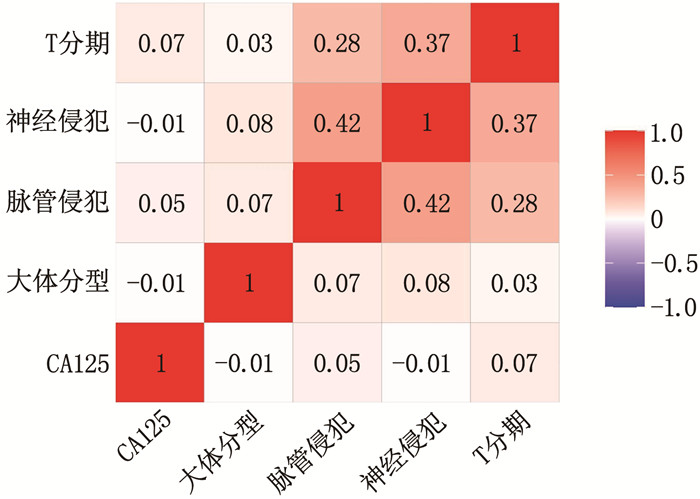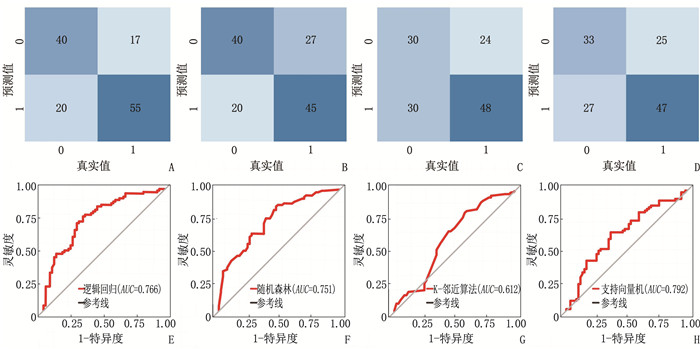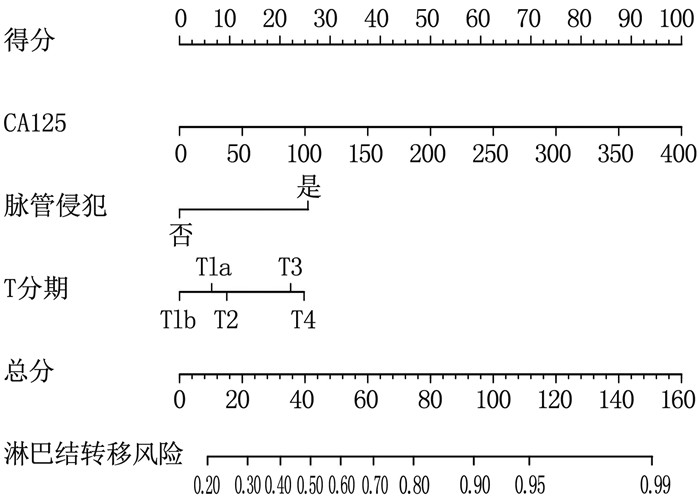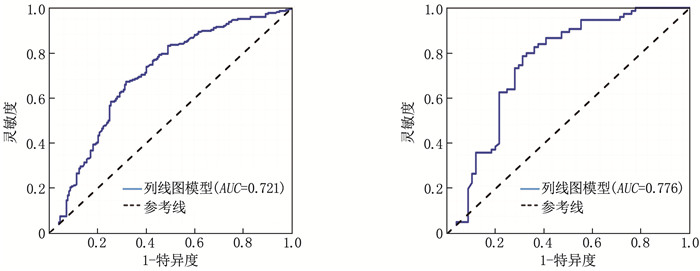Research on gastric cancer lymph node metastasis prediction model based on machine learning algorithms
-
摘要:目的
基于4种机器学习(ML)算法构建胃癌淋巴结转移的预测模型并验证。
方法回顾性收集531例胃癌根治术患者的临床资料, 按3∶1比例将患者随机分为训练集399例和测试集132例。通过单因素分析筛选胃癌淋巴结转移的特征选择变量,分别建立逻辑回归、随机森林、K-邻近算法、支持向量机算法模型并进行变量重要性排序。将所有ML算法模型在测试集中进行验证,绘制受试者工作特征(ROC)曲线,基于曲线下面积(AUC)、灵敏度、特异度、准确度确定最优ML算法模型。基于最优ML算法模型的变量重要性排序构建列线图模型,通过ROC曲线、校准曲线、决策曲线评价列线图模型的区分能力、校准能力和临床适用性。
结果4种ML算法模型比较结果显示,随机森林模型为最优算法模型,其在训练集中的准确度、灵敏度、特异度分别为72.7%、69.9%、75.0%, AUC为0.803, 其在测试集中的准确度、灵敏度、特异度分别为64.4%、66.7%、62.5%, AUC为0.751。基于随机森林算法模型的变量构建列线图模型, ROC曲线显示列线图模型在训练集、测试集中的AUC分别为0.721、0.776, 校准曲线和决策曲线显示列线图模型在训练集与测试集中均有较好的校准能力和临床适用性。
结论随机森林模型是4种ML算法模型中的最优算法模型,基于随机森林模型构建的列线图模型能够较准确地预测胃癌淋巴结转移风险,从而更好地指导临床诊断和治疗决策。
Abstract:ObjectiveTo establish and validate a prediction model for gastric cancer lymph node metastasis based on four machine learning (ML) algorithms.
MethodsA retrospective analysis was conducted on clinical data of 531 patients who underwent radical gastrectomy. The patients were randomly divided into training set (399 patients) and test set (132 patients) in a ratio of 3 to 1. Univariate analysis was used to screen for variables associated with gastric cancer lymph node metastasis, and Logistic regression, random forest, K-nearest neighbor algorithm, and support vector machine algorithm models were established to rank the importance of variables. All ML algorithm models were validated in the test set, and receiver operating characteristic (ROC) curves were plotted. The optimal ML algorithm model was determined based on the area under the curve (AUC), sensitivity, specificity, and accuracy. A nomogram model was constructed based on the variable importance ranking of the optimal ML algorithm model. The discrimination, calibration, and clinical applicability of the nomogram model were evaluated using ROC curves, calibration curves, and decision curves.
ResultsThe results of the comparison of the four ML algorithm models showed that the random forest model was the optimal algorithm model. The accuracy, sensitivity, and specificity of the random forest model in the training set were 72.7%, 69.9%, and 75.0%, respectively, with an AUC of 0.803. The accuracy, sensitivity, and specificity of the random forest model in the test set were 64.4%, 66.7%, and 62.5%, respectively, with an AUC of 0.751. A nomogram model was constructed based on the variables of the random forest algorithm model. The ROC curve showed that the AUCs of the nomogram model in the training set and test set were 0.721 and 0.776, respectively. Calibration curves and decision curves showed that the nomogram model had good calibration and clinical applicability in both the training set and test set.
ConclusionThe random forest model is the optimal algorithm model among the four ML algorithm models. The nomogram model based on the random forest model can accurately predict the risk of gastric cancer lymph node metastasis, thereby better guiding clinical diagnosis and treatment decisions.
-
血管平滑肌肉瘤是一种少见的肿瘤,其中源自下腔静脉的下腔静脉平滑肌肉瘤更为罕见,每100 000成人中不足1例[1]。肿瘤起源于血管的中膜,在早期阶段,其局限于静脉壁(附壁生长),随后通过侵入邻近结构(腔外)或以血栓的形式(腔内)扩张,其生长方式有静脉内型、静脉外型及混合型,其中以静脉外型最常见[2]。该病好发于中老年女性, 50~60岁女性患者约占80%[3], 其病因未明,有报道表明[4-5]其病因可能与雌激素和孕激素有关。目前,原发性下腔静脉平滑肌肉瘤(PIVCLMS)的诊断和治疗在临床上仍是一个难题。本文就PIVCLMS诊疗进展进行综述,以期为临床工作提供参考。
1. 临床表现
由于下腔静脉平滑肌肉瘤的位置隐匿及生长过程缓慢,通常到中晚期才出现临床症状,并且临床表现无特异性。临床上根据肾静脉和肝静脉的解剖位置, PIVCLMS可分为3段: 上段(Ⅰ段),肝静脉至右心房; 中段(Ⅱ段),肾静脉段到肝静脉段; 下段(Ⅲ段),肾静脉以下。文献[6-7]报道, Ⅰ段约占20%, Ⅱ段约占44%, Ⅲ段约占36%(如图 1)。Ⅰ段主要表现为恶心、呕吐、布加综合征、右心衰或体质量减轻; Ⅱ段可出现腹痛、腹部肿块,当肿瘤侵犯右肾静脉或继发血栓形成时,常伴有肾病综合征或血管性高血压; Ⅲ段大多表现为右下腹及背部疼痛或下肢水肿。超过60%的患者可出现非特异性腹痛[8]。
2. 病理、免疫及遗传学特征
下腔静脉平滑肌肉瘤多为圆形或椭圆形结节状肿块,肿瘤边界清晰,不侵犯周围组织,但常与周围组织粘连,部分有假包膜。肿瘤呈灰白色或灰红色,较大的肿瘤可伴有出血、坏死、部分可有囊性退变。镜下肿瘤与静脉壁关系密切,瘤细胞大小不一,细胞呈梭形、短梭形,以束状、编织状交错紧密排列。细胞核大、染色深,胞浆丰富,核分裂象多见[9]。PIVCLMS常用标志物包括平滑肌肌动蛋白、结蛋白和高分子量钙结合蛋白。这些标志物在70%以上的病例中呈阳性[10], 由于这些标记物在PIVCLMS中并非完全特异, 2种或3种阳性更有助于下腔静脉平滑肌肉瘤的诊断。此外,角蛋白、上皮细胞膜抗原、CD34和S100蛋白可呈局灶性阳性。PIVCLMS的核型非常复杂,其形成可能与TP53缺陷有关,视网膜母细胞瘤-细胞周期调节蛋白D途径的异常也可能参与其形成,其基因组在13q14丢失,以RB1基因为中心[11]。文献[10]表明, PIVCLMS有多种分子亚型,不同亚型预后存在明显差异。受体酪氨酸激酶样孤儿素受体2 (ROR2)的表达可能在下腔静脉平滑肌肉瘤的侵袭性中起着重要作用,并预示着不良的临床结果。
3. 诊断
PIVCLMS无典型的症状、体征,也无特异的影像学表现,且无可靠的肿瘤标记物,术前难以确诊。早期下腔静脉造影是该病有效的诊断方法,随着无创影像学技术的快速发展,其诊断水平也显著提高。①超声检查: 超声检查简便、经济、无创,可以动态观察病情进展,是下腔静脉相关疾病治疗前检查和治疗后复查的最常用方法。B型超声可以准确地确定下腔静脉中肿块的位置,但不能鉴别良恶性。研究[12]报道,超声造影(CEUS)可以显示病变的灌注情况,有助于下腔静脉疾病良恶性的诊断。② CT: CT可以提供更多的信息, CT检查平扫肿瘤呈软组织密度,增强后呈轻度不均匀强化,但与其他的占位性病变较难鉴别。研究[3]发现, CT血管造影(CTV)能显示PIVCLMS病变的位置、大小及病变受累情况,对PIVCLMS诊断及治疗有极大的帮助,推荐其为首选的检查方法。③ MRI: MRI被认为是目前较为理想的无创性检查方法,其表现为T1WI等或稍低信号, T2WI等高混杂信号,增强扫描后呈不均匀强化。其可以清楚显示病灶全貌及肿瘤累及范围,还可以纵向观察到截断征象或充盈缺损,而且可以显示侧支循环形成的程度,有文献[13]报道称MRI结合三维动态增强磁共振血管造影(3D CE-MRV), 不仅能明确下腔静脉与肝肾静脉之间的关系,还能观察到周围侧支循环的建立程度,同时也能完整显示瘤体的长度及累及的范围,可代替传统的下腔静脉造影,作为诊断PIVCLMS的首选的无创性检查方法。国外研究[14]团队提出,高分辨率磁共振血管造影结合高浓度钆喷酸葡胺可更好地显示血管及血管周围结构,可以为临床工作者提供更多有用的信息,可作为下腔静脉平滑肌肉瘤精确的术前诊断方法。因此,临床上对可疑PIVCLMS患者,可行超声初步评估,若有占位等阳性表现可行CT及MRI进一步验证。但最终确诊仍需组织学分析,组织的获取通常通过开腹手术或经皮穿刺活检完成。
穿刺活检可明确肿瘤的性质,但无法明确肿瘤的来源,且极易造成穿刺路径的肿瘤种植, ZHENG W等[15]反对此项检查。有报道[16]表明穿刺活检与大出血风险相关,发生率可达8.3%。国外研究[17]采用以导管为基础的微创血管内活检技术和以数字减影血管造影(DSA)为辅助的导管抽吸活检技术,出血更少,并发症更低,可安全确诊。诊断下腔静脉平滑肌肉瘤的主要标准是: ①肿瘤毗邻下腔静脉,肿瘤不能脱离下腔静脉; ②肿瘤累及的下腔静脉段壁结构被肿瘤破坏; ③免疫组化检查可见平滑肌肌动蛋白; ④在显微镜下肿瘤细胞分化不良。综上,临床上对于有腹痛等症状的患者,除考虑常见病外,还应该考虑PIVCLMS的可能,尤其是B超、CT检查提示下腔静脉附近有包块时,可行CTA、3D CE-MRV等提高检出率。
4. 鉴别诊断
PIVCLMS需与胰头、十二指肠、右肾、右肾上腺及腹膜后来源的肿瘤进行鉴别,此外也需要与下腔静脉血栓进行鉴别。霍奇金淋巴瘤和非霍奇金淋巴瘤均可累及腹膜后。腹膜后淋巴瘤可表现为多个肿大的淋巴结或肿块样淋巴结的聚集,后者表现更像下腔静脉平滑肌肉瘤。淋巴瘤最常见的是T1低信号, T2等信号或高信号,伴有中度增强。淋巴瘤在下腔静脉中癌栓形成概率较低,此外多有发烧、盗汗和体质量减轻或伴乳酸盐脱氢酶(LDH)水平升高[18]。脂肪肉瘤是最常见的原发性腹膜后肿瘤,多见于50~70岁患者。脂肪肉瘤通常较大,类似于下腔静脉平滑肌肉瘤。肿瘤因组织学亚型而异,低分化肿瘤表现为大、界限清楚的肿物,内部有肉眼可见的脂肪,鉴于其内部有肉眼可见的脂肪,低分化脂肪肉瘤很容易区别于下腔静脉平滑肌肉瘤。高分化脂肪肉瘤,包括黏液样脂肪肉瘤、圆形细胞型脂肪肉瘤和多形型脂肪肉瘤,可能含有很少或没有肉眼可见的脂肪。在没有肉眼可见脂肪的情况下,肿瘤与下腔静脉界限一般较清楚,有利于其鉴别[19]。神经源性肿瘤占腹膜后肿瘤的10%~20%。与下腔静脉平滑肌肉瘤相比,神经源性肿瘤影响较年轻的患者群体,预后较好。此外PIVCLMS还需与下列疾病鉴别诊断:下腔静脉血栓,一般有下肢静脉炎病史,血栓无强化,一般较易鉴别; 下腔静脉癌栓,通常来自肾脏、肾上腺、胰头或肝脏的肿瘤,有原发灶的影像学表现,管腔扩张程度较轻,管腔内癌栓可见强化; 下腔静脉平滑肌瘤,多伴有子宫肌瘤,由子宫肌层中的平滑肌瘤细胞侵及血管并沿盆腔静脉生长而来,一般对管壁无恶性浸润。
5. 治疗
5.1 手术治疗
PIVCLMS起初被视为无法手术的肿瘤,但随着对下腔静脉平滑肌肉瘤的深入研究,外科学、麻醉学和重症监护学等方面的进步,以及人工血管技术的快速发展,此禁区取得了较大的突破[20]。目前,根治性肿瘤切除术已证明可以治愈PIVCLMS[21]。患者术后3、5和10年的总生存期分别为87.5%、75.0%和56.3%[22]。肿瘤外科及心胸血管外科的发展进步及多学科合作确保了肿瘤的充分切除和静脉的重建,手术的关键是切缘阴性和下腔静脉的重建。下腔静脉的重建有多种选择,包括IVC结扎、单纯缝合或补片修补、端端吻合、置换术等。
对于下段PIVCLMS(Ⅲ段),可直接行简单的结扎。下端下腔静脉有丰富的侧支循环,如果不累及髂内、髂外静脉分叉处,则可通过髂内静脉与盆腔静脉吻合来保证下肢静脉回流,这种情况下直接结扎几乎无下肢水肿等并发症发生[23]。此时切除的范围应上起肾静脉入口下达髂总静脉分叉,保留髂内、髂外静脉汇合处,可有效避免盲端血栓。JIANG H等[24]提出简单结扎的原则: ①病史超过1年,有足够的侧支循环形成者; ②至少有75%的IVC管腔堵塞者; ③患者术前静脉注射20 mg呋塞米,在下腔静脉暂时阻断后30 min内可产生100 mL以上的尿液。当肿瘤位于髂静脉并累计髂总静脉分叉处时,必须切除髂总静脉分叉,在这种情况下,需要重建,因为简单的结扎不能保证足够的静脉回流。为了便于重建,可以在髂外静脉和髂内静脉之间进行端侧吻合。简单的IVC结扎可以避免血管重建的并发症,如血栓形成、出血,以及在假体使用中出现的感染和血栓等并发症。此外, IVC简单的结扎避免了复杂的血管重建,并且能够减少手术时间、节约手术成本。
对于中段PIVCLMS(Ⅱ段),手术的关键在于肾静脉的重建。右肾静脉短且只接受右侧输尿管静脉回流,缺乏侧支循环,当肿瘤侵犯右肾静脉时,简单结扎右肾静脉可引起肾淤血及肾衰竭,一般行右肾切除术。由于右肾静脉短,行右肾静脉重建在手术方式上相对复杂。右肾静脉重建的方法有多种,可与精索静脉端端吻合,或移植大隐静脉重建。LIU D等[25]提出肾静脉成形术(VRO)是保留肾静脉和重建肾流出道的有效方法,可达到近90%的通畅率,还可有效减少术中及术后出血。THEODORAKI K等[26]报道将左肾静脉与肠系膜下静脉(IMV)进行吻合,右肾静脉植入肝后IVC残端,术后肾功能恢复良好,无血尿等明显不适。由于左肾静脉可与半奇静脉及椎静脉吻合,可同时接受左肾上腺静脉、左性腺静脉、左腰静脉和左腿下静脉干。由于有充分的侧支循环,当累及左肾静脉时,可行左肾静脉结扎而不会出现肾功能衰竭。当无侧支循环形成或其他原因行左肾静脉重建时,由于左肾静脉较长,其重建较右肾静脉简单。
累及上段PIVCLMS(I段)手术方法最为复杂。当肿瘤侵犯肝静脉或者累及右心房时,须在低温、静脉转流术、体外循环基础上行肿瘤切除后人工血管重建,甚至自体肝移植。国外有团队[27]归纳了同时行肝切除术伴下腔静脉重建患者240例,总住院死亡率为6.25% (15/240), 85%可以达到根治切除。因此,当累及肝脏的下腔静脉肿瘤切除是安全有效的,提倡上段PIVCLMS侵及肝脏时,积极行手术治疗。当PIVCLMS侵犯心脏时,患者预后较差。LV Y等[28]总结了近20年来PubMed收录的30例下腔静脉平滑肌肉瘤累及心脏的患者,有14例累及右心室,平均发病年龄为53.6岁,女性占67%, 平均随访存活时间为15个月,远低于中下段。笔者认为当肿瘤累及中下段及肝静脉时,可积极行根治切除加血管重建,手术风险及并发症较少。而对于累及心脏者,手术风险及预后较差,若患者心肺功能及一般情况较差,可联合肿瘤内科制订适合患者的方案。
肿瘤切除后,可行单纯缝合、补片修复或移植物重建。为了避免静脉狭窄,小于20%的缺损可行单纯缝合[5]。补片修复适用于较大的缺陷。移植物重建符合正常的生理解剖,可以有效保证肿瘤的完整切除,还可以预防下肢肿胀及肾功能衰竭。相关文献[29]推荐使用聚四氟乙烯(PTFE)作为IVC重建的移植物,因其在弥补缺损的长度和对腹内压的抵抗力方面具有良好的效果。移植物塌陷是血栓形成的主要危险因素,临床上常用较小的移植物增加流速预防血栓。此外,有报道[30]通过动静脉瘘增加血流量避免血栓形成。移植物5年临床通畅率为92%[31], 移植物相关死亡率为0%, 移植相关并发症发生率为2%。尽管移植物广泛用于切除后重建,但其可发生血栓栓塞、感染和抗凝治疗有关的并发症。IVC切除和重建术后抗凝的使用没有明确的指南,仍有争议。笔者认为具有既往静脉血栓栓塞病史,术中大量出血和输血引起的凝血异常、肿瘤较大、肝静脉或肾静脉植入患者,应积极抗凝治疗。
5.2 辅助治疗
PIVCLMS放化疗作用尚不清楚,目前没有明确的证据表明辅助治疗能改善长期生存率。研究[22, 32]表明,辅助治疗可以减缓疾病进展,提高疾病稳定性,在无法行根治性切除术时为较好的方案,且可以在治疗中控制局部病变。鉴于PIVCLMS的罕见性,很难进行大队列前瞻性研究来评估辅助疗法的疗效。目前,大多数治疗方案是基于标准肿瘤学原则,并从腹膜后肉瘤的研究中推断出来。在美国国家癌症数据(NCDB)一项大型分析中, NUSSBAUM D P等[33]发现,与单独手术治疗腹膜后肉瘤相比,术前放疗和术后放疗均与总体生存率的提高显著相关。专门评估PIVCLMS的研究团队[22]也发现了辅助治疗的益处。
对于晚期PIVCLMS, 辅助治疗能否为下腔静脉平滑肌肉瘤患者带来生存获益,目前尚无明确结论,仍需要更多研究加以证实。若患者无法行手术切除,放化疗也许是一种可行的治疗方案。治疗PIVCLMS的方案见图 2。
6. 总结与展望
PIVCLMS病因未明,无典型症状及体征,诊断困难,易与腹膜后疾病相混淆,发生误诊,导致误治,临床需给予重视。随着影像学技术的快速发展,其术前检出率也显著提高。目前,根治性切除术是唯一证实可以治愈的手段。PIVCLMS的诊断及治疗应多学科诊疗,并结合患者的个体化特征,此外,还需要多中心、前瞻性的随机临床试验来评估辅助治疗的作用。
-
表 1 训练集与测试集患者临床资料比较[n(%)][M(P25, P75)]
临床资料 分类 训练集(n=399) 测试集(n=132) χ2/Z P 性别 男 312(78.2) 102(77.3) 0.049 0.825 女 87(21.8) 30(22.7) 年龄/岁 58.0(50.0, 63.5) 59.0(50.5, 64.0) -0.650 0.516 民族 汉族 304(76.2) 106(80.3) 2.365 0.500 回族 42(10.5) 8(6.1) 藏族 37(9.3) 13(9.8) 其他 16(4.0) 5(3.8) 体质量指数/(kg/m2) 22.5(20.4, 24.9) 22.5(20.7, 24.9) -0.086 0.932 高血压 否 348(87.2) 116(87.9) 0.039 3 0.843 是 51(12.8) 16(12.1) 糖尿病 否 382(95.7) 121(91.7) 3.294 0.070 是 17(4.3) 11(8.3) 白蛋白/(g/L) 39.3(36.8, 41.9) 39.3(36.7, 41.5) -0.684 0.494 肿瘤标志物 AFP/(ng/mL) 2.2(1.7, 3.1) 2.3(1.6, 3.3) -0.106 0.916 CEA/(ng/mL) 2.0(1.3, 3.5) 2.2(1.4, 3.7) -1.169 0.242 CA125/(U/mL) 11.0(8.1, 16.4) 11.1(8.4, 14.6) -0.461 0.645 CA199/(U/mL) 7.2(3.3, 18.4) 9.8(3.2, 24.7) -1.524 0.127 肿瘤直径 < 2 cm 40(10.0) 10(7.6) 0.698 0.404 ≥2 cm 359(90.0) 122(92.4) 肿瘤位置 胃上部1/3 93(23.3) 40(30.3) 2.590 0.274 胃中部1/3 282(70.7) 85(64.4) 胃下部1/3 24(6.0) 7(5.3) 大体分型 溃疡型 350(87.7) 115(87.1) 1.355 0.508 隆起型 30(7.5) 13(9.8) 浸润型 19(4.8) 4(3.0) 分化程度 高分化 29(7.3) 17(12.9) 4.803 0.091 中分化 221(55.4) 63(47.7) 低分化 149(37.3) 52(39.4) 脉管侵犯 否 148(37.1) 53(40.2) 0.394 0.530 是 251(62.9) 79(59.8) 神经侵犯 否 174(43.6) 64(48.5) 0.953 0.329 是 225(56.4) 68(51.5) T分期 T1a期 13(3.3) 6(4.5) 5.143 0.273 T1b期 5(1.3) 4(3.0) T2期 122(30.6) 44(33.3) T3期 32(8.0) 5(3.8) T4期 227(56.9) 73(55.3) 淋巴结转移 否 183(45.9) 60(45.5) 0.006 0.935 是 216(54.1) 72(54.5) AFP: 甲胎蛋白; CEA: 癌胚抗原; CA125: 糖类抗原125; CA199: 糖类抗原199。 表 2 无淋巴结转移组与淋巴结转移组患者临床资料比较[n(%)][M(P25, P75)]
特征 分类 无淋巴结转移组(n=243) 淋巴结转移组(n=288) χ2/Z P 性别 男 192(79.0) 222(77.1) 0.285 0.593 女 51(21.0) 66(22.9) 年龄/岁 58.0(50.0, 63.0) 59.0(50.0, 64.0) -0.593 0.553 民族 汉族 195(80.2) 215(74.7) 2.370 0.499 回族 20(8.2) 30(10.4) 藏族 20(8.2) 30(10.4) 其他 8(3.3) 13(4.5) 体质量指数/(kg/m2) 22.4(20.7, 24.7) 22.5(20.2, 25.0) -0.189 0.850 高血压 否 213(87.7) 251(87.2) 0.030 0.862 是 30(12.3) 37(12.8) 糖尿病 否 231(95.1) 272(94.4) 0.101 0.751 是 12(4.9) 16(5.6) 白蛋白/(g/L) 39.4(36.8, 41.5) 39.3(36.6, 42.1) -0.065 0.948 肿瘤标志物 AFP/(ng/mL) 2.3(1.8, 3.2) 2.2(1.6, 3.0) -1.219 0.223 CEA/(ng/mL) 2.0(1.3, 3.1) 2.0(1.3, 4.0) -1.328 0.184 CA125/(U/mL) 10.5(7.8, 14.3) 11.4(8.4, 17.0) -2.385 0.017 CA199/(U/mL) 7.3(3.3, 14.4) 9.2(3.2, 28.3) -1.927 0.054 肿瘤直径 < 2 cm 29(11.9) 21(7.3) 3.330 0.068 ≥2 cm 214(88.1) 267(92.7) 肿瘤位置 胃上部1/3 59(24.3) 74(25.7) 0.203 0.903 胃中部1/3 169(69.5) 198(68.8) 胃下部1/3 15(6.2) 16(5.6) 大体分型 溃疡型 216(88.9) 249(86.5) 8.582 0.014 隆起型 23(9.5) 20(6.9) 浸润型 4(1.6) 19(6.6) 分化程度 高分化 24(9.9) 22(7.6) 1.318 0.517 中分化 132(54.3) 152(52.8) 低分化 87(35.8) 114(39.6) 脉管侵犯 否 139(57.2) 62(21.5) 71.299 < 0.001 是 104(42.8) 226(78.5) 神经侵犯 否 140(57.6) 98(34.0) 29.644 < 0.001 是 103(42.4) 190(66.0) T分期 T1a期 16(6.6) 3(1.0) 41.015 < 0.001 T1b期 6(2.5) 3(1.0) T2期 100(41.2) 66(22.9) T3期 16(6.6) 21(7.3) T4期 105(43.2) 195(67.7) 表 3 不同机器学习算法模型在训练集和测试集中的预测效能
数据集 模型 准确度/% 灵敏度/% 特异度/% AUC 训练集 逻辑回归模型 69.2 60.7 76.4 0.727 随机森林模型 72.7 69.9 75.0 0.803 K-邻近算法模型 68.9 58.5 77.8 0.772 支持向量机模型 71.9 64.5 78.2 0.792 测试集 逻辑回归模型 71.9 66.7 76.4 0.766 随机森林模型 64.4 66.7 62.5 0.751 K-邻近算法模型 58.3 48.3 66.7 0.612 支持向量机模型 60.6 55.0 65.3 0.637 -
[1] KINAMI S, SAITO H, TAKAMURA H. Significance of lymph node metastasis in the treatment of gastric cancer and current challenges in determining the extent of metastasis[J]. Front Oncol, 2021, 11: 806162.
[2] KIKUCHI S, KURODA S, NISHIZAKI M, et al. Management of early gastric cancer that meet the indication for radical lymph node dissection following endoscopic resection: a retrospective cohort analysis[J]. BMC Surg, 2017, 17(1): 72. doi: 10.1186/s12893-017-0268-0
[3] IASONOS A, SCHRAG D, RAJ G V, et al. How to build and interpret a nomogram for cancer prognosis[J]. J Clin Oncol, 2008, 26(8): 1364-1370. doi: 10.1200/JCO.2007.12.9791
[4] ZHAO L Y, YIN Y, LI X, et al. A nomogram composed of clinicopathologic features and preoperative serum tumor markers to predict lymph node metastasis in early gastric cancer patients[J]. Oncotarget, 2016, 7(37): 59630-59639. doi: 10.18632/oncotarget.10732
[5] HANDELMAN G S, KOK H K, CHANDRA R V, et al. eDoctor: machine learning and the future of medicine[J]. J Intern Med, 2018, 284(6): 603-619. doi: 10.1111/joim.12822
[6] LIU W C, LI Z Q, LUO Z W, et al. Machine learning for the prediction of bone metastasis in patients with newly diagnosed thyroid cancer[J]. Cancer Med, 2021, 10(8): 2802-2811. doi: 10.1002/cam4.3776
[7] ZHU J, ZHENG J X, LI L F, et al. Application of machine learning algorithms to predict central lymph node metastasis in T1-T2, non-invasive, and clinically node negative papillary thyroid carcinoma[J]. Front Med, 2021, 8: 635771. doi: 10.3389/fmed.2021.635771
[8] SANTOS M K, FERREIRA JUNIOR J R, WADA D T, et al. Artificial intelligence, machine learning, computer-aided diagnosis, and radiomics: advances in imaging towards to precision medicine[J]. Radiol Bras, 2019, 52(6): 387-396. doi: 10.1590/0100-3984.2019.0049
[9] KANG J, CHOI Y J, KIM I K, et al. LASSO-based machine learning algorithm for prediction of lymph node metastasis in T1 colorectal cancer[J]. Cancer Res Treat, 2021, 53(3): 773-783. doi: 10.4143/crt.2020.974
[10] 曹毛毛, 陈万青. GLOBOCAN 2020全球癌症统计数据解读[J]. 中国医学前沿杂志: 电子版, 2021, 13(3): 63-69. [11] SONGUN I, PUTTER H, KRANENBARG E M, et al. Surgical treatment of gastric cancer: 15-year follow-up results of the randomised nationwide Dutch D1D2 trial[J]. Lancet Oncol, 2010, 11(5): 439-449. doi: 10.1016/S1470-2045(10)70070-X
[12] LAWSON J D, SICKLICK J K, FANTA P T. Gastric cancer[J]. Curr Probl Cancer, 2011, 35(3): 97-127. doi: 10.1016/j.currproblcancer.2011.03.001
[13] MCCULLOCH P, NITA M E, KAZI H, et al. Extended versus limited lymph nodes dissection technique for adenocarcinoma of the stomach[J]. Cochrane Database Syst Rev, 2004(4): CD001964.
[14] 郑晋, 桑玉尔, 施伟斌. 胃癌病人淋巴结转移nomogram图预测模型构建及评价[J]. 中国实用外科杂志, 2021, 41(5): 570-575, 580. [15] LIN J X, WANG Z K, WANG W, et al. Risk factors of lymph node metastasis or lymphovascular invasion for early gastric cancer: a practical and effective predictive model based on international multicenter data[J]. BMC Cancer, 2019, 19(1): 1048. doi: 10.1186/s12885-019-6147-6
[16] YIN X Y, PANG T, LIU Y, et al. Development and validation of a nomogram for preoperative prediction of lymph node metastasis in early gastric cancer[J]. World J Surg Oncol, 2020, 18(1): 2. doi: 10.1186/s12957-019-1778-2
[17] BAI B L, WU Z Y, WENG S J, et al. Application of interpretable machine learning algorithms to predict distant metastasis in osteosarcoma[J]. Cancer Med, 2023, 12(4): 5025-5034. doi: 10.1002/cam4.5225
[18] STERNE J A, WHITE I R, CARLIN J B, et al. Multiple imputation for missing data in epidemiological and clinical research: potential and pitfalls[J]. BMJ, 2009, 338: b2393. doi: 10.1136/bmj.b2393
[19] HONG W D, LU Y J, ZHOU X Y, et al. Usefulness of random forest algorithm in predicting severe acute pancreatitis[J]. Front Cell Infect Microbiol, 2022, 12: 893294. doi: 10.3389/fcimb.2022.893294
[20] WANG R, ZUO C L, ZHANG R, et al. Carcinoembryonic antigen, carbohydrate antigen 199 and carbohydrate antigen 724 in gastric cancer and their relationship with clinical prognosis[J]. World J Gastrointest Oncol, 2023, 15(8): 1475-1485. doi: 10.4251/wjgo.v15.i8.1475
[21] 王妤, 褚嘉栋, 孙娜, 等. 围产期抑郁症辅助诊断预测模型的构建及机器学习算法的筛选[J]. 实用临床医药杂志, 2023, 27(18): 93-99. doi: 10.7619/jcmp.20232044





 下载:
下载:








 苏公网安备 32100302010246号
苏公网安备 32100302010246号
